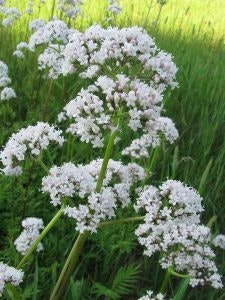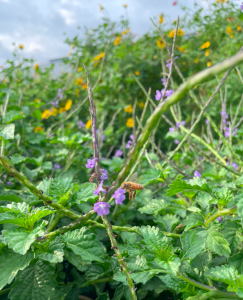Harvesting Health: Medicinal Plants for the Central Florida Garden
UF/IFAS June 12, 2024
by Heather Kalaman
Central Florida’s ample sunlight and moderate rainfall create optimal conditions for cultivating a diverse array of herbs celebrated for their medicinal qualities. Gardeners and herbal enthusiasts in the region can establish vibrant medicinal gardens that not only showcase the aesthetic beauty of these plants, but also serve as reservoirs of natural remedies. Whether incorporated into backyard gardens or larger community spaces, the cultivation of medicinal plants in Central Florida fosters a connection between residents and the rich herbal traditions that have been passed down through generations.
In our new medicinal garden here at UF/IFAS Extension Orange County, the interplay between horticulture and health takes center stage! So, let’s delve into the rich tapestry of medicinal flora appropriate for growing here in Central Florida.
Yarrow (Achillea millefolium):Yarrow is a versatile and resilient herb with a long history of medicinal use. Its feathery leaves and clusters of tiny, delicate flowers make it a charming addition to any garden. Yarrow is prized for its anti-inflammatory properties and ability to staunch bleeding, making it a valuable herb for treating wounds, bruises, and skin irritations. This hardy perennial thrives in a variety of conditions, including poor soil and full sun, making it an easy-to-grow herb for gardens in Florida and beyond.

Dark blue corn flower (Centaurea cyanus): Dark blue corn flower offers a range of medicinal properties that have been utilized for centuries. Its petals contain antioxidants and anti-inflammatory compounds, making it valuable in traditional herbal medicine for promoting overall health and wellness. Cornflower tea is often consumed for its potential to alleviate eye strain and discomfort, while its astringent properties make it useful in skincare products for toning and soothing the skin. Additionally, cornflower has been used to support digestive health and reduce fever. A favorite among pollinators, it thrives in full sun and well-drained soils.

Valerian (Valeriana officinalis): Valerian, scientifically known as Valeriana officinalis, is a perennial herb native to Europe and Asia but widely cultivated around the world for its medicinal properties. It has a long history of use as a natural remedy for promoting relaxation and improving sleep quality. Valerian root contains compounds that have a calming effect on the nervous system, making it a popular choice for managing stress and anxiety. This hardy herb thrives in moist, well-drained soil and partial shade, making it suitable for cultivation in various climates, including Florida. The fragrant flowers of Valerian also attract beneficial pollinators to your garden, highlighting its ecological benefits as well.

Mullein (Verbascum thapsus): In the face of respiratory discomfort, mullein stands tall as a go-to remedy. Native to Europe, Asia, and Africa, it has naturalized in many parts of the world, including North America. Mullein has a long history of medicinal use, particularly for respiratory ailments such as coughs and bronchitis. This is a biennial herbaceous plant characterized by its tall stalks and fuzzy leaves. Its tall spikes of yellow flowers attract pollinators, adding beauty to gardens while providing medicinal benefits. Easy to grow in well-drained soil and full sun, mullein is a valuable addition to any herbal garden.

Marshmallow (Althaea officinalis): Despite its sweet-sounding name, marshmallow is not just a confectionary delight but also a medicinal marvel. Native to Europe and naturalized in Central Florida, this herb’s roots contain mucilage, a gel-like substance that coats and soothes the digestive tract. Central Floridians have embraced marshmallow as a remedy for various digestive issues, finding relief from conditions such as indigestion and gastritis. Cultivated worldwide for its medicinal properties, it is easy to grow in moist, well-drained soil and full sun to partial shade.

Astragalus (Astragalus membranaceus):Central Florida’s herbal arsenal includes astragalus or Huang Qi, a plant known for its immune-boosting properties. With its roots deeply embedded in traditional Chinese medicine, astragalus is valued for promoting overall vitality and resilience. Astragalus root contains compounds believed to support overall health and vitality, aiding in the body’s ability to cope with stress and illness. Easy to grow in well-drained soil and full sun, astragalus offers a natural way to support wellness and resilience.

Ashwagandha (Withania somnifera):Ashwagandha is a perennial herb native to India and North Africa but cultivated in various regions for its medicinal properties. It has a rich history in Ayurvedic medicine, where it is prized for its adaptogenic qualities, helping the body manage stress and promoting overall well-being. Ashwagandha root contains bioactive compounds like withanolides, believed to possess anti-inflammatory and immune-modulating effects. Easy to grow in warm climates like Florida, Ashwagandha thrives in well-drained soil and full sun to partial shade.

Lance leaf Coreopsis (Coreopsis lanceolata):Coreopsis possesses several medicinal properties that have been recognized for centuries. Its leaves and flowers contain bioactive compounds with anti-inflammatory and antioxidant properties, making it valuable in traditional herbal medicine. Tickseed has been used to alleviate fevers, headaches, and respiratory ailments. Additionally, it is believed to have diuretic properties and may aid in digestive health. Its cheerful yellow flowers bloom profusely throughout the summer, enhancing the beauty of your garden while providing medicinal benefits.

Blanket flower (Gaillardia pulchella):Gaillardia pulchella, also known as Indian Blanket or Firewheel, boasts medicinal properties that have been appreciated in traditional herbal medicine. Its vibrant flowers contain bioactive compounds with anti-inflammatory and antimicrobial properties, making it valuable for treating skin irritations and wounds. Indian Blanket has also been used to alleviate digestive issues and reduce fever. Gaillardia pulchella serves as a natural and colorful addition to any herbal garden and is also a pollinator favorite.

Sweet basil (Ociumum basilicum):Sweet basil, also known as Ocimum basilicum, is not only cherished for its culinary delights but also esteemed for its medicinal properties. Rich in antioxidants and essential oils, sweet basil possesses anti-inflammatory and antimicrobial qualities, making it a valuable herb for combating infections and supporting overall immune health. Its aromatic leaves contain compounds like eugenol, which has been studied for its potential to alleviate pain and reduce inflammation, making sweet basil a versatile herb with a long history of therapeutic use in traditional medicine systems around the world.

Chickweed (Stellaria media):Stellaria media, commonly known as Chickweed, is a humble herb with powerful medicinal properties. It is rich in vitamins and minerals, making it a nutritious addition to salads or soups. Chickweed also possesses anti-inflammatory and demulcent properties, soothing irritated skin and promoting wound healing. This hardy herb thrives in moist soil and partial shade.

Borage (Borage officinalis): Borage is an herbaceous plant with beautiful blue flowers that not only adds aesthetic appeal to your garden but also offers medicinal benefits. Its leaves and flowers are rich in gamma-linolenic acid (GLA), an essential fatty acid with anti-inflammatory properties, making it beneficial for managing inflammatory conditions such as arthritis and skin disorders like eczema. Borage is also known to have diuretic properties, promoting kidney health and aiding in detoxification. Additionally, its leaves have been used traditionally to alleviate coughs and respiratory ailments. This herb is easy to grow in Florida’s climate, preferring full sun and well-drained soils.

Porterweed (Stachytarphetajamaicensis): A native Florida plant, porterweed offers notable medicinal benefits that have been recognized in traditional herbal medicine. Its leaves contain compounds with anti-inflammatory and antimicrobial properties, making it valuable for treating skin conditions such as wounds, insect bites, and rashes. Additionally, porter weed has been used to alleviate fevers and digestive issues. Porter Weed is drought-tolerant and thrives in full sun, making it a low-maintenance addition to your Florida garden.

Sweet Alyssum (Lobularia maritima):While primarily grown for its ornamental value, it has been used in traditional herbal medicine for its mild expectorant and anti-inflammatory properties. The leaves and flowers of sweet alyssum contain compounds that may help soothe respiratory issues such as coughs and congestion when brewed into a tea or used in aromatherapy. Additionally, its delicate fragrance is believed to have calming effects, promoting relaxation and stress relief. Sweet alyssum thrives in well drained soils, rich in organic matter and full sun to partial shade.

The establishment of this garden owes its existence to the gracious seed donation from Revival Gardening and Strictly Medicinal Seeds and the exceptional dedication of our remarkable garden technicians, David Scheck and Troy Bailey. Without these generous efforts, creating and nurturing this garden would not have been possible.
